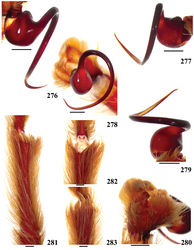Ybyrapora diversipes
| Notice: | This page is derived from the original publication listed below, whose author(s) should always be credited. Further contributors may edit and improve the content of this page and, consequently, need to be credited as well (see page history). Any assessment of factual correctness requires a careful review of the original article as well as of subsequent contributions.
If you are uncertain whether your planned contribution is correct or not, we suggest that you use the associated discussion page instead of editing the page directly. This page should be cited as follows (rationale):
Citation formats to copy and paste
BibTeX: @article{Fukushima2017ZooKeys, RIS/ Endnote: TY - JOUR Wikipedia/ Citizendium: <ref name="Fukushima2017ZooKeys">{{Citation See also the citation download page at the journal. |
Ordo: ORDO
Familia: FAMILIA
Genus: Ybyrapora
Name
Ybyrapora diversipes (C. L. Koch, 1842) comb. n. – Wikispecies link – Pensoft Profile
- Mygale diversipes C. L. Koch, 1841: 65, pl. CCCX, fig. 731 (lectotype female, Brazil, Bahia, Freir. leg., ZMB 2943, examined).
- Eurypelma diversipes: C. L. Koch 1850[1]: 73; Simon 1864[2]: 67, 1892[3]: 172; Ausserer 1871[4]: 202; Roewer 1942[5]: 239; Bonnet 1955[6]: 1831; 1957[7]: 2990.
- Avicularia diversipes: F. O. Pickard-Cambridge 1896[8]: 744; Bertani and Fukushima 2009[9]: 26 (figs 1–4, 13–15, 17, Appendix I, figs A1–A6); Bertani 2102: 5, 79; 80, 88; World Spider Catalog 2016[10].
Diagnosis
(amended from Bertani and Fukushima 2009[9]). Females differ from those of Ybyrapora sooretama comb. n. and Ybyrapora gamba comb. n. by presenting very long, strongly curved outwards spermathecae with its distal portion almost reaching the spermathecae base (Fig. 259). Males differ from those of Ybyrapora gamba sp. comb. n. and Ybyrapora sooretama comb. n. by having embolus more than four times tegulum’s length, with strong curvature in frontal view (Fig. 278) and cymbium with well-developed process bearing thick setae on retrolateral lobe (Fig. 280).
Material examined
Female, Brazil, state of Bahia, Ilhéus, CEPLAC [14°46'S, 39°13'W], R. Bertani & G. Puorto col., March 1991 (IBSP 11754); male, same locality, collectors and date (IBSP 119271 ref. 64.583).
Diagnosis, other material examined, description, color pattern ontogeny, distribution and natural history
See Bertani and Fukushima (2009)[9].
Complementary description
Male: Palp (Figs 276–279): globous bulb with small subtegulum, lacking prominence on tegulum. Embolus: not flattened, lacking keels, 7.76 long in retrolateral view, about 7 times tegulum’s length. Medial portion and tegulum’s margin form very acute angle in retrolateral view. Proximal part very curved in frontal view; thin distal width, tapering distally; basal, middle, and distal width of 1.05, 0.35, 0.08 respectively. Tegulum: 1.89 long, 1.08 high. (Fig. 319). Cymbium subtriangular with subequal lobes, with a well-developed rounded process on retrolateral lobe, bearing thick setae (Fig. 280).
Tibia I with discrete elevation covered by a cluster of setae in apical portion, on prolateral side (Figs 281–283).
Type II urticating setae: 0.791–0.860 long; 0.017–0.020 wide in male; 0.427–0.520 long; 0.012–0.016 wide in female.
Female: Spermathecae (Fig. 259): two completely separated, not-twisted very long spermathecae, with walls lacking lobes and accentuated outwards curvature medially. Spermatheca midwidth as wide as its base width, virtually non-sclerotized.
Taxon Treatment
- Fukushima, C; Bertani, R; 2017: Taxonomic revision and cladistic analysis of Avicularia Lamarck, 1818 (Araneae, Theraphosidae, Aviculariinae) with description of three new aviculariine genera01 ZooKeys, (659): 1-185. doi
Images
|
Other References
- ↑ Koch C (1850) Übersicht des Arachnidensystems. Nürnberg, Heft 5, 1–77. https://doi.org/10.5962/bhl.title.39561
- ↑ Simon E (1864) Histoire naturelle des araignées (aranéides). Paris, 540 pp. https://doi.org/10.5962/bhl.title.47654
- ↑ Simon E (1892) Histoire naturelle des araignées. Paris, tome 1, 1084 pp. https://doi.org/10.5962/bhl.title.51973
- ↑ Ausserer A (1871) Beiträge zur Kenntniss der Arachniden-Familie der Territelariae Thorell (Mygalidae Autor). Verhandlungen der Zoologisch-Botanischen Gesellschaft (Wien) 21: 117–224. http://www.biodiversitylibrary.org/page/16425408#page/271/mode/1up
- ↑ Roewer C (1942) Katalog der Araneae von 1758 bis 1940. Bremen 1: 1–1040.
- ↑ Bonnet P (1955) Bibliographie araneorum. Analyse méthodique de toute la littérature aranéologique jusqu’en 1939. Douladoure, Tolouse, Part 2, tome 2, 919–1926.
- ↑ Bonnet P (1957) Bibliographia araneorum. Analyse méthodique de toute la littérature aranéologique jusqu’en 1939. Douladoure, Toulouse, Part 2, tome 3, 1927–3026.
- ↑ Pickard-Cambridge F (1896) On the Theraphosidae of the lower Amazons: being an account of the new genera and species of this group of spiders discovered during the expedition of the steamship “Faraday” up the river Amazons. Proceedings of the Zoological Society of London 1896: 716–766. http://www.biodiversitylibrary.org/page/31200747#page/810/mode/1up
- ↑ 9.0 9.1 9.2 Bertani R, Fukushima C (2009) Description of two new species of Avicularia Lamarck, 1818 and redescription of Avicularia diversipes (C. L. Koch, 1842) (Araneae, Theraphosidae, Aviculariinae)— three possibly threatened Brazilian species. Zootaxa 2223: 25–47. https://doi.org/10.11646/zootaxa.2223.1.2
- ↑ World Spider Catalog (2016). World Spider Catalog. Natural History Museum Bern http://wsc.nmbe.ch, version 17.5



